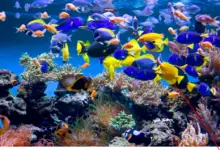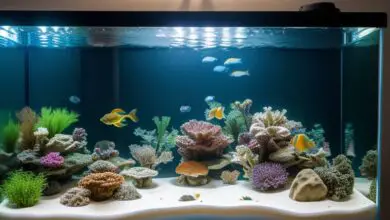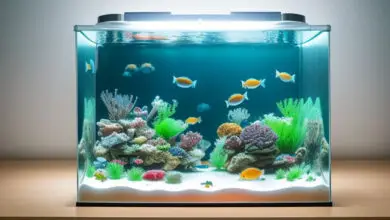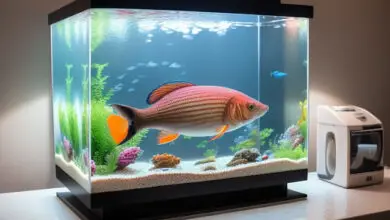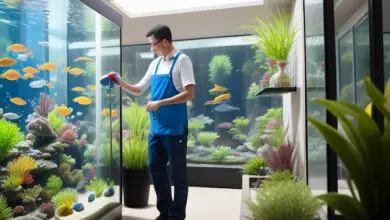8 Wonderful Examples of Natural-Looking Aquariums Showing Special Places

Some aquariums are set up to look like small parts of streams, rivers, and lakes found in nature. These “biotope” aquariums only have plants and fish that come from that same place in the wild. The aquariums try to copy the conditions and look of those areas so the fish and plants feel like home. This helps the fish behave normal and stay healthy.
What Are Biotope Aquariums?
Biotope tanks aim to recreate tiny pieces of natural water places like African lakes or South American flooded forests. They pick plants, fish, decorations and water types matching that place. Biotopes show off cool species in environments they live in, not fancy aquarium art. The fish get spaces meeting their needs best. Recreating their home habitats keeps fish calmer.
Focusing On Real Nature Areas
Biotopes make aquariums that mimic streams and ponds species actually live in. Things like water flow, plants, wood, rocks, light and shelter all try to naturally match the area. Fish living with the conditions and tank mates from their home ranges do best. Making natural looking spaces for them feels more relaxing.
Showcasing Special Regional Places
Lots of different water places exist worldwide for fish. Slow, acidic streams have some kinds while big rocky lakes have others uniquely adapted there. Small sections of these environments get remade in biotope aquariums. Fish and plants shown together live in that same place outside. Tanks can highlight cool species from interesting spots.
Amazon Forest Streams Biotope
The gigantic Amazon rainforest has extremely many plant and animal species living in its intricate branch stream networks. Even tiny home aquarium versions capture some of its magic.
Flooded Forest Look
Many Amazon fish live around sunken wood and dense plant root tangles when seasonal floods cover low plains. Recreate this by leaning and piling branches from one side to more open water on the other. Background inserts or mossed panels represent bordering trees and vegetation.
Fish & Plants From There
Classic Amazon fish like angelfish plus neon and other tetras swim through the branches with Corydoras catfish along the bottom. Use tough leafed plants attached to the wood resembling growth in flooded zones. Tall stems like Amazon swords make a backdrop while short carpeting ones often get too shaded.
Congo River Forest Streams
Africa’s Congo River is Earth’s second biggest by water volume after the Amazon. It has amazingly rich wildlife still being discovered in its surrounding ancient rainforests. Even small home aquarium versions showcase its magic.
West Africa Stream Look
The lower Congo exiting the rainforest enters a coastal delta region before reaching the Atlantic Ocean. Recreate views of the forest lined banks and channels using blackwater extract for gentle tea stain color. Allow floating plants in backwater areas and open torrents for fish to cruise.
Fish & Plants From There
Congo tetra school together through plant stands above Corydoras catfish hunting food particles. Broad leafed Anubias and Bolbitis with tall Vallisneria or fern plants densely cover backdrops and wood hardscapes. Colorful African cichlids like goby cichlids and rainbow kribensis showcase vibrant hues uncommon in stores.
Florida Wetlands Streams
Florida’s wide wetland regions with cypress forest bays and streams have wildlife adapted for seasonal rainfall changes. Tannin stained waters from oak leaves tint pools where bright platys and swordtails shine against darker ambience.
Everglades Look
The iconic River of Grass sawgrass prairies permeate Florida wetlands. Aquariums can recreate the look with wide and tall leafed background plants encircling a more open center channel. Weathered manzanita branches with air plants clinging among leaf litter conjure images of swampy cypress knees seen rising from the dark smooth waters.
Fish & Plants From There
Active livebearers like male guppies, platies, swordtails and mollies add movement. Smaller tetras and Corydoras zip through the composition above loaches poking about the bed. Consider brackish compatible species like mollies and archerfish able to handle occasional salt treatments. Florida flagfish and pygmy sunfish represent interesting natives.
Lake Tanganyika Rocky Shore Biotope
Lake Tanganyika in East Africa has incredibly unique cichlids, snails and other species living in its rocky nearshore zone environments. Showcasing vibrant little shell dwelling cichlids in dedicated small aquariums provides engaging snapshots of their obscure habitat ranges.
Rocky Setting
Rock piles, stacked slate formations and smooth gravel beds mimic the craggy islands fish depend upon for shelter and territories. Shelving rock platforms built up the back wall help define separate little claimed zones for species needing distinct sightline broken up areas.
Fish & Plants From There
Tough leaved plants like Java fern, Anubias and Vallisneria suit the rough conditions and water chemistry. Small shell dwellers like brightly colored lamprologus cichlids partition off and defend their little rock pile kingdoms from others. Selective breeding produced striking extra color variants.
South America Floodplain Streams
Brazil’s giant Pantanal wetlands transform into an interconnected aquatic landscape during seasonal flooding rains. Capturing phases of that dynamic seasonal transformation when temporary streams and ponds overflow proves an exciting challenge!
Flood Period Changes
While completely submerged when flooded, drying periods leave more defined streams and pools. Mimic drastic seasonal variations by movable foam-mounted plant rows switched between background and foreground. Arrange according to high or low water levels when rescaping the phases.
Fish & Plants From There
Peaceful schools of tetras and rasboras with Corydoras cats cruise through curtains of leafy stem plants. When “flooded” plants float freely and obscure boundaries. Subdued natural tones keep focus on the fish and fluid plant movement. Dense clusters slow currents for shy grazers while open lanes let streamlined dithers flash their colors zipping through the motifs.
Southeast Asia Blackwater Streams
Slack water jungle streams stained dark from leaf tannins carry unique species like wild bettas and tiny rasboras through Southeast Asian swamps. The challenging water conditions prove rewarding for recreating slices of their shadowy forest pool environments.
Blackwater Stream Look
Decomposing leaves and plants release tannins and acids creating a gentle tea stain color and lower pH resembling natural blackwaters species inhabit. Recreate similar lighting and water quality using rooibos tea, dried leaves or cones to leach botanical compounds. Go very light on fertilizers, targeting mosses, ferns and anubias suited to low nutrients.
Fish & Plants From There
Spidery wood, leaf litter and mosses set the theme. Shade plants like Java ferns and bucephalandra grow naturally in forested seeps and outlets. Soft water species like wild bettas, pygmy rasboras and glass shrimp appreciate tangles of branches and darkened waters. Dense planting lets shy fish establish domains with less stress.
European Mountain Brook Biotope
Crisp mineralized melt waters cascading down mountain slopes form aquatic ecosystems with unique organisms adapted to the constant cold flows across rocky creek beds. Translating the dynamic environment makes an engaging fluid biotope project.
Rushing Water Look
Mimicking highly oxygenated turbulent flows defines mountain stream biotopes. Canister filters paired with water pumps tilted along the front pane generate surface ripples and fluttering plant movement suggesting rushing currents fish expect.
Fish & Plants From There
Coldwater fish like minnows, loaches and catfish suit the brisk conditions. Tough leaved plants like Java fern and moss anchor to crevices in rock pile structures. Built up stone slopes form shaded shelves where grazers pick at nutritious biofilm and surface insects while still bracing against unrelenting currents.
Australian Desert Waterhole
Boom and bust cycles follow infrequent rainy periods across Australia’s arid landscapes where adapted species persist in isolated pools until the next uncertain downpour. Challenging to maintain, ephemeral waters still prove interesting subjects to recreate in alignment with their temporary flush phases.
Drying Stream Bed Look
Focus becomes the clear waters between rainfalls when levels drop, vegetation dies back and mud hardens. Position taller plants off to the sides preserving open visibility important for characteristic fish. Driftwood and rock positions shift representing contracting shorelines as water disappears.
Fish & Plants From There
Australian natives like rainbowfish and desert gobies together with shrimp enliven the barren vista between unpredictable flood pulses. Vallisneria and anubias sprout along transient bank zones. Concentrated schools take advantage of temporary bounty before seasonal heat evaporates the scattered oases away until the next monsoon rains.
Closing Thoughts
Biotope aquariums highlight special regional freshwater environments and uncommon species. Concentrating on accurately portraying conditions helps fish and plants from targeted places stay healthy and exhibit natural behaviors better. Aquariums mimicking even small sections of the amazing aquatic habitats across our planet provide rewarding windows into those unique underwater worlds. Hopefully these examples stir inspiration to recreate one!

